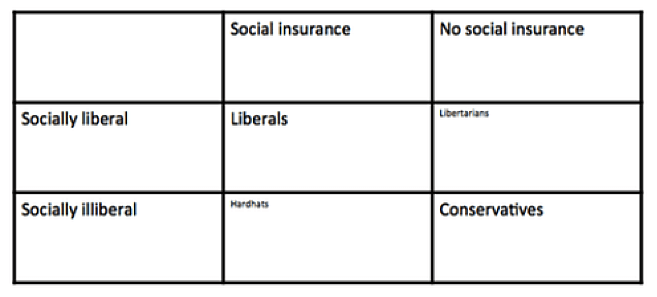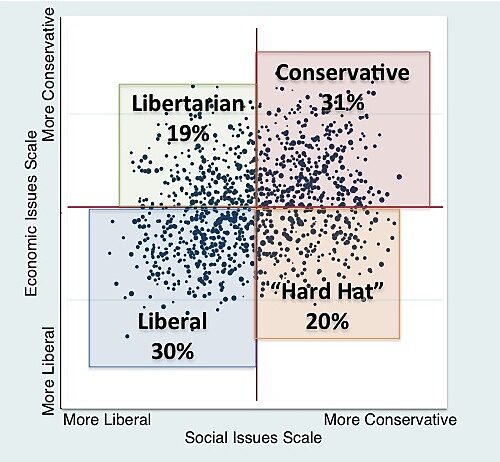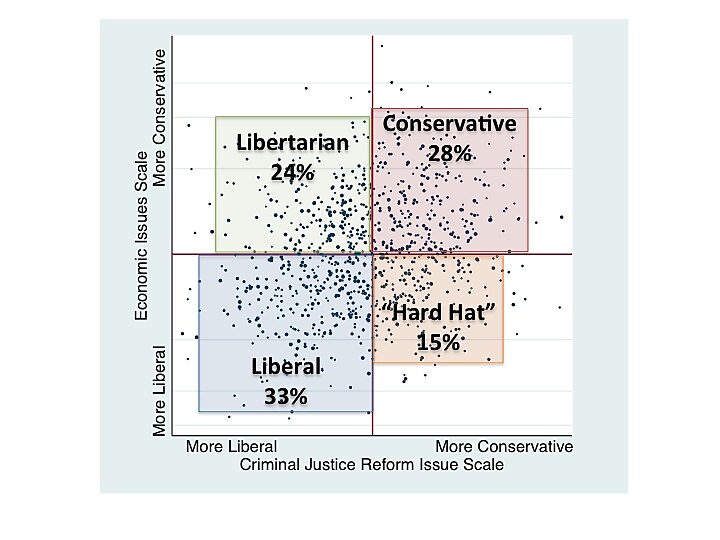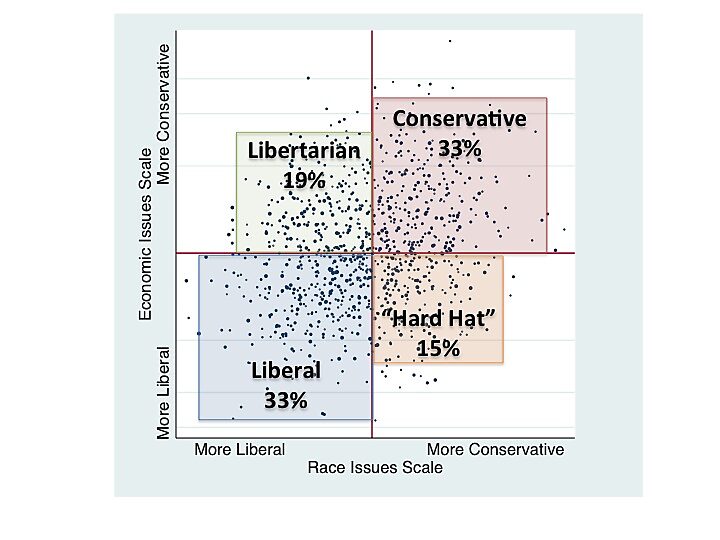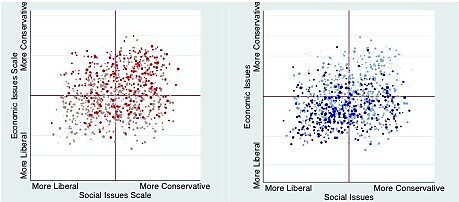In light of “libertarianish” Sen. Rand Paul’s recently announced candidacy for president, the New York Times’ Paul Krugman veered into public opinion to make a bold claim that most Americans are either liberal or conservative and little else.
He explains that in theory there could be more than simply liberals and conservatives. For instance, if political attitudes were structured along multiple dimensions like along economics and social issues, that would produce at least four different ideological groups:
- Liberals (economically and socially liberal)
- Conservatives (economically and socially conservative)
- Libertarians (socially liberal and economically conservative)
- “Hard hats” or communitarians (socially conservative and economically liberal)
Yet, without referencing data, he asserts that in practice few people exist in the libertarian or “hard hat” (or communitarian) boxes. His graphic is pasted below:
Is Krugman’s estimate accurate? A growing body of literature overwhelmingly suggests that it isn’t. (For instance see here, here, here, here, here, also see here, among others.)
For this reason, it’s not surprising that statisticians and academics used survey data in response to Krugman to demonstrate that Americans are more complicated than just red and blue. For instance, Nate Silver at FiveThirtyEight cross-tabs support for wealth redistribution and same-sex marriage to show about a quarter of Americans fit in the libertarian box: oppose income redistribution and support marriage equality.
However, one could argue that by this definition, based on only these two questions, Paul (who indirectly instigated this debate) may not even be categorized in the “libertarian” box.
Perhaps a more precise way to measure this is to use multiple issue questions to derive a measure of each person’s ideology on economic issues, and multiple questions to estimate their ideology on social issues, and then use their scores as coordinates to map them across the four quadrants.
Figure 1 uses survey data from the American National Election Study Evaluations of Government and Society Survey 2 (EGSS 2). I average responses to several questions about economics to create an “economic issues scale” scaled from liberal to conservative. Similarly, I use questions about immigration and religion for a “social issues scale” scaled from liberal to conservative. (All question wording is found in the footnotes below.) Thus, each respondent is assigned an “economics” and “social” ideology score used to map their ideological coordinates and placement in one of the four boxes.
Figure 1 reveals a complicated electorate with 19 percent in the libertarian bucket (economically conservative and socially liberal) and 20 percent in the “hard hat” box (economically liberal and social conservative). This is a far cry from Krugman’s estimate of “basically empty” boxes.
Where Do The People Live, Politically Speaking?
Figure 1
[caption]
Note: ANES 2012 EGSS 2, each dot represents an individual respondent. The Social Issues Scale is coded left to right, liberal to conservative. The Economics Issue Scale is coded bottom to top, liberal to conservative.[/caption]
These measures also find that 31 percent conform to traditional conservative and 30 percent to traditional liberal issues positions on both economic and social issues respectively.
What’s helpful about these graphs is that we can map out spatially where Americans are politically relative to each other. We can notice that Americans are not grouped together as pundits may believe and politicians may desire.
Results are not limited to just these particular questions. I replicate these general findings by plotting ideology on criminal justice reform issues versus economic ideology and then again with race issues versus economic ideology, using data from the Reason-Rupe/Princeton October 2014 national survey.
Notably, the share of libertarians and “hard-hats” is contingent upon the questions asked.
Figure 2 plots the ideological coordinates for individual survey respondents based on their answers to economic issues questions (y‑axis) and criminal justice reform issues (x‑axis). In fact, the criminal justice questions map onto issues differentiating Paul from other Republican presidential contenders. These variables include support for allowing nonviolent offenders to petition to have their court records sealed, perception of racial bias in the criminal justice system, and support/opposition to racial profiling. (Question wordings found in footnotes.)
Once again, the libertarian and “hard hat” buckets are quite full. Some 24 percent are in the libertarian bucket because respondents give “liberal” responses to criminal justice reform questions and conservative responses to economic questions. Another 15 percent are in the “hard hat” bucket because they expressed more conservative opinions on criminal justice issues and liberal views on fiscal issues. Another 33 percent were in the traditional liberal and 28 percent in the conservative buckets.
Criminal Justice Reform by Economic Issues
Figure 2
[caption]
Note: Reason/Princeton October 2014, each dot represents an individual respondent.[/caption]
Figure 3 maps ideology using answers to questions on economics and racial issues. The results: liberal, 33%; conservative, 33%; libertarian, 19%; communitarian, 15%. (Question wordings in footnote.)
Racial Issues by Economic Issues
Figure 3
[caption]
Note: Reason/Princeton October 2014, each dot represents an individual respondent.[/caption]
So what about traditional partisan groups? Where do they “live” in the political map? I map this in Figure 4. As expected, Republicans are more likely to cluster in the upper right, traditionally conservative quadrant, and Democrats in the lower left, traditionally liberal quadrant. Independents are fairly evenly distributed but slightly more represented in the hard hat and libertarian boxes.
Where Do the Republicans and Democrats Live?
Figure 4
[caption]
Note: ANES EGSS 2 2012 Survey, Red dots indicate Republican respondents (LEFT), Blue dotes indicate Democratic respondents (RIGHT).[/caption]
Like partisans, organized groups tend to come from the traditional liberal and conservative quadrants. For instance, labor unionists and members of environmental, women’s and LGBT rights groups and antiwar activists disproportionately come from the traditional liberal quadrant. Born-again Christians are disproportionately found in the traditional conservative and hard-hat buckets. Gun owners are found primarily in the conservative quadrant. Tea Partiers are found mostly in the conservative quadrant but also in the libertarian box.
This offers some insight as to why pundits tend to overlook the libertarian and hard hat boxes. Few groups seem to mobilize the libertarian and hard hat voters. Moreover, these Americans are somewhat less likely to vote and engage politically. Nearly equal shares of traditional liberals (72%) and conservatives (73%) said they were 100% likely to vote in the 2012 election, compared to 67 percent of libertarians and only 48 percent of hard hats.
When examining these groups’ other political activity, traditional liberals; (42%) were the most likely to have engaged in the 2012 election by calling an elected official, donating money or time to a campaign or cause, etc. However, only 22 percent of hard-hats did the same. Conservatives and libertarians were in the middle with about 3 in 10 engaging politically in 2012.
As some have said, “the world is run by those who show up.” Similarly, government goes to those who show up, and we pay attention to those who mobilize and engage. At the moment, hard hats and libertarians are often less likely to engage, mobilize, and vote, and thus perhaps more easily overlooked.
One will notice that the non-traditional Republican candidate Paul does the best (as does Jeb Bush) compared to their traditional Republican rivals in hypothetical matchups with Democratic frontrunner Hillary Clinton. Is Paul cutting into Clinton’s base? Or is he demonstrating an ability to mobilize new voters to his advantage? What about Bush? We’ll need more data to answer those questions.
Thinking beyond 2016, it stands to reason that candidates who choose to ignore hardhats and libertarians are at a disadvantage. Instead, candidates who seek to build larger coalitions outside of the traditional Democratic and Republican bases by appealing to libertarian and hardhat voters may find additional success.
Footnotes:
American National Election Study Evaluations of Government and Society Survey 2, 2012
Economics
Do you think that the government should provide more services than it does now, fewer services than it does now, or about the same number of services as it does now? How important is it to reduce the deficit? (Extremely important, very important, moderately important, a little important, or not important at all.) Different ways of handling the deficit have been considered. Which one of these do you prefer? (Do not reduce, tax increases only, spending cuts only, spending cuts & tax increases.) With the deficit in mind, do you favor raising, lowering, or keeping the same taxes for people who make more than $250,000 per year? Households with the highest 20% of incomes earn an average of 14.9 times as much money as households in the bottom 20%. Should this difference be larger, smaller, or about the same as it is now? Some people feel that the government in Washington should see to it that every person has a job and a good standard of living; Others think the government should just let each person get ahead on their own. Where would you place yourself on this scale? Do you think estates should not be taxed at all, only estates worth more than $5 million should be taxed, only estimates worth more than $1 million should be taxed, all estates should be taxed
Social
Which comes closest to your view about what government policy should be toward unauthorized immigrants now living in the United States? Should the government (1) make all unauthorized immigrants felons and send them back to their home country? (2) have a guest worker program that allows unauthorized immigrants to remain in the United States in order to work, but only for a limited amount of time? (3) allow unauthorized immigrants to remain in the United States and eventually qualify for U.S. citizenship, but only if they meet certain requirements like paying back taxes and fines, learning English, and passing background checks, or (4) allow unauthorized immigrants to remain in the United States and eventually qualify for U. S. citizenship, without penalties?
Which of these statements comes closest to your feelings about the (Bible/Torah/Holy Scripture)? (1) The (Bible/Torah/Holy Scripture) is the actual word of God and is to be taken literally, word for word. (2) The (Bible/Torah/Holy Scripture) is the word of God but not everything in it should be taken literally, word for word. (3) The (Bible/Torah/Holy Scripture) is a book written by people and is not the word of God.
Reason Foundation-Rupe Foundation/Princeton 2014
Race Issues
It has been reported that some police officers stop motorists or pedestrians of certain racial or ethnic groups because the officers believe that these groups are more likely than others to commit certain types of crimes. Do you approve or disapprove of this practice by the police? In recent years, do you think too much has been made of the problems facing black people, too little has been made, or is it about right? Just your impression: do you think the criminal justice system in the United States (1) treats white Americans more fairly than black and Hispanic Americans, (2) treats black and Hispanic Americans more fairly than white Americans, or (3) are they treated about the same?
Criminal Justice and Racial Equality
It has been reported that some police officers stop motorists or pedestrians of certain racial or ethnic groups because the officers believe that these groups are more likely than others to commit certain types of crimes. Do you approve or disapprove of this practice by the police? Do you favor or oppose allowing nonviolent drug offenders who have served their sentences to petition a court to have their court records sealed, making them inaccessible to the public without a court order? Just your impression: do you think the criminal justice system in the United States (1) treats white Americans more fairly than black and Hispanic Americans) (2) treats black and Hispanic Americans more fairly than white Americans, or (3) are they treated about the same?
Economics
Looking back now on the 2008 financial crisis… Do you think the government definitely did the right thing, probably did the right thing, probably did the wrong thing, or definitely did the wrong thing? As you may know, the U.S. has one of the highest corporate income tax rates among industrialized countries. Do you favor raising U.S. corporate tax rates, keeping U.S. corporate tax rates where they are now, lowering U.S. corporate tax rates to match those of other industrialized countries, or lowering U.S. corporate tax rates below those of other industrialized countries? If you had to choose, would you rather have a smaller government providing fewer services, or a larger government providing more services? As I read the following pairs of statements, please tell me which comes closer to your own opinion: we need a strong government to handle today’s complex economic problems; or, people would be better able to handle today’s problems within a free market with less government involvement.
